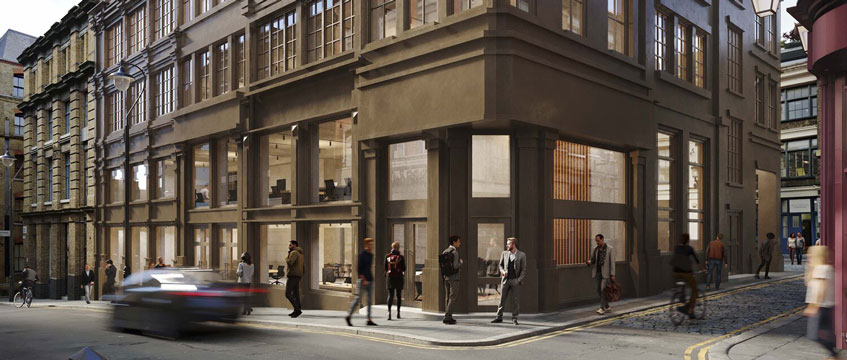Farringdon is not an area of London usually associated with the secretive, tradition-dominated world of private banking. The up-and-coming City fringe district is better known for a recent influx of tech occupiers, whose young, trainer-clad employees have flooded back to the office since pandemic restrictions were lifted. Snapchat, TikTok and Depop have all made the area their home over the past year. More are expected to follow as major office schemes complete in the coming months.
But earlier this year, Swiss bank Julius Baer completed a deal to move its 200-strong London workforce to 20-23 Greville Street (pictured), a newly refurbished building within sight of Farringdon station. The 130-year-old financial powerhouse’s bankers, whose well-heeled private clients must make a minimum investment of £2.3m just to get a look-in, are currently based at 1 St Martin’s Le Grand, an ornate Victorian pile close to St Paul’s Cathedral which has almost as many historic blue plaques as it does tenants. So why are they moving to the City fringe?
READ MORE: UBS circles fellow Swiss bank’s HQ in record City fringe buy
Alan Hooks, managing director and head of private clients at Julius Baer, says the decision is part of an innovation push at the bank. “Farringdon feels like a modern, progressive community of businesses, and it was a big attraction for us to be a part of that. It does not feel particularly stuffy or pretentious,” he says. “That is important to us in terms of our reputation and the way we present ourselves to our own client base, who are constantly changing.”
The building itself, a 35,600 sq ft scheme set over six storeys, has been updated to incorporate new facades. Two new upper floors are constructed partly from eco-friendly cross-laminated timber, and the building is more energy-efficient than the 1970s-built block that came before it. For Julius Baer, the sustainability credentials were a vital part of the decision to move.
“It goes hand in hand with what we want for our people and our clients. We are keen to participate in [the ESG agenda], and having a building which reflects this is part of that,” Hooks says. “Things like being energy-efficient and having greater control over our consumption of electricity or water is super-important. We want our headquarters to demonstrate that we are serious about this.”
Flexibility to the fore
Most important, however, is the flexibility the new site offers in comparison with Julius Baer’s current digs. The move will be a significant contraction in space from 47,000 sq ft to 27,000 sq ft, but Hooks thinks the ability to reconfigure that floorspace creatively with exercise and wellbeing areas will more than make up for the downsize.
“What we are hearing from candidates looking to join Julius Baer is that they are looking at a broader reward than just traditional [financial] compensation,” he adds. “Having a good and healthy working environment helps us make that available to them.”
The bank will also benefit from being better able to ensure its space is “aligned to people’s working patterns”, Hooks adds. Julius Baer adopted a hybrid working strategy last summer and is still working through the finer details of how that will work over the years to come.
Hooks says the decision to downsize the office predates Covid-19. The firm had carried out a pre-pandemic analysis on space requirements in its existing office, leading bosses to adapt it as best they could, he says. “That, in turn, helped us understand how we would use any future space, and what we would need going forward in terms of the overall capacity.”
He continues: “We want teams to come and collaborate, and to be able to change the space depending on what is needed from it. Plus, we want to give people the chance to socialise with friends and colleagues. It has become very apparent over the past couple of years that this is a crucial factor for employees.”

Meet the neighbours
The new office also facilitates better technology, which has increasingly become a sticking point for meeting-heavy professions in the hybrid era. The space will include features such as surround cameras, interactive displays and larger screens in meeting rooms, which Hooks describes as a “step forward” from the bank’s existing premises.
Nonetheless, he insists that for all of Farringdon’s trendy, up-and-coming status, Julius Baer is unlikely to be entirely in step with its more contemporary neighbours. “We want to be part and parcel of the community, we want to be part of the neighbourhood,” he says. “But we are very proud of our tradition.”
So will the team still be wearing suits and ties come moving day? “We’ll see about that.”
To send feedback, e-mail alex.daniel@eg.co.uk or tweet @alexmdaniel or @EGPropertyNews











